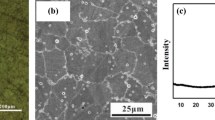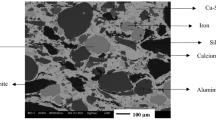Abstract
Sliding friction tests were carried out on quenched and aged unlubricated samples of C17200 beryllium bronze with and without the current flow through frictional contact. It is shown that the quenched samples are exposed to corrosion-mechanical wear by the oxidation of the friction surface, followed by the separation of wear particles as ultradispersed oxides. The wear of the aged sample is attended by the separation of big wear particles as a result of adhesive interaction. The application of electric current in sliding allows reducing the wear resistance of quenched bronze to 109.3 h/g as compared to the 143.9 h/g of the sample tested without current. The application of electricity results only in a negligible reduction in the wear resistance of the aged bronze samples from 86.6 to 77.8 h/g.






Similar content being viewed by others
REFERENCES
ASM Specialty Handbook: Copper and Copper Alloys, Davis, J.R., Ed., Materials Park, OH: ASM Int., 2001.
Lomakin, I., Castillo-Rodriguez, M., and Sauvage, X., Microstructure, mechanical properties and aging behavior of nanocrystalline copper–beryllium alloy, Mater. Sci. Eng., A, 2019, vol. 744, pp. 206–214.
Baburaj, E.G., Kulkarni, U.D., Menon, E.S.K., and Krishnan, R., CuBe precipitation in Cu–Be alloys, Phase Transition, 1979, vol. 1, no. 2, pp. 171–179.
Zhu, D., Liu, C., Liu, Y., Han, T., Gao, Y., and Jiang, S., Evolution of the texture, mechanical properties, and microstructure of Cu–2.7Be alloys during hot cross-rolling, Appl. Phys. A, 2015, vol. 120, no. 4, pp. 1605–1613.
Korshunov, L.G., Chernenko, N.L., and Korznikov, A.V., Effect of the severe plastic deformation and aging temperature on the strengthening, structure, and wear resistance of a beryllium bronze, Phys. Met. Metallogr., 2011, vol. 111, no. 4, pp. 395–402.
Altunpak, Y., Wear behavior of aged Cu-Be alloy under electrical sliding, Sci. Res. Essays, 2010, vol. 5, no. 19, pp. 2997–3002.
Khodabakhshi, A., Abouei, V., Mortazavi, N., Razavi, S.H., Hooshyar, H., and Esmaily, M., Effects of cold working and heat treatment on microstructure and wear behavior of Cu–Be alloy C17200, Tribol.-Mater., Surf. Interfaces, 2015, vol. 9, no. 3, pp. 118–127.
Straffelini, G., Maines, L., Pellizzari, M., and Scardi, P., Dry sliding wear of CuBe alloys, Wear, 2005, vol. 259, pp. 506–511.
Scardi, P., Leoni, M., Straffelini, G., and Giudici, G.D., Microstructure of Cu–Be alloy triboxidative wear debris, Acta Mater., 2007, vol. 55, no. 7, 2531–2538.
Kwok, C.T., Wong, P.K., Man, H.C., and Cheng, F.T., Sliding wear and corrosion resistance of copper-based overhead catenary for traction systems, Int. J. Railway, 2010, vol. 3, no. 1, pp. 19–27.
Kukareko, V.A., Role of the structural state of a copper–beryllium alloy in the formation of its tribotechnical properties, Phys. Met. Metallogr., 2017, vol. 118, no. 5, pp. 472–478.
Popov, V., Generalized archard law of wear based on Rabinowicz criterion of wear particle formation, Facta Univ., Ser.: Mech. Eng., 2019, vol. 17, no. 1, pp. 39–45.
Rubtsov, V.E. and Kolubaev, A.V., Plastic deformation and quasi-periodic vibrations in a tribological system, Techn. Phys., 2004, vol. 49, no. 11, pp. 1457–1463.
ACKNOWLEDGMENTS
We thank V. V. Fadin for assistance in conducting the experiment. The test results by scanning electron microscopy were obtained in the Nanotech Shared Use Center at the Institute of Strength Physics and Materials Sciences (SB RAS) and in the Academic Center “Physics and Chemistry of High Energy Systems” at the Tomsk State University.
Funding
This work was written as part of the state task for the ISPMS SB RAS, project no. III.23.2.4.
Author information
Authors and Affiliations
Corresponding author
Additional information
Translated by S. Kuznetsov
About this article
Cite this article
Kolubaev, A.V., Sizova, O.V., Teryukalova, N.V. et al. Wear of Quenched and Aged Cu–Be Alloy at Current Transfer. J. Frict. Wear 41, 559–564 (2020). https://doi.org/10.3103/S1068366620060112
Received:
Revised:
Accepted:
Published:
Issue Date:
DOI: https://doi.org/10.3103/S1068366620060112




